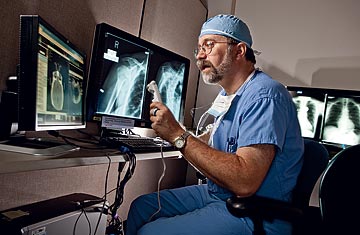
A doctor dictates notes into the digital archive.
(2 of 3)
Geisinger uses a little of all three strategies. Founded in 1915 as a 70-bed hospital in a small, underserved rural community, the operation now spans a 43-county region, with a total of 67 sites — stretching from one-doctor offices and in-store clinics to a sprawling main campus in Danville, Pa. Like Kaiser, the 13,000-employee Geisinger is both a care provider and an insurer. About 30% of its 783,000 patients have the in-house coverage; the remaining 70% are covered by other private insurers or Medicare.
Geisinger's brand of care can take some getting used to — at least for the doctors. Come to work for Geisinger and the first thing you notice is that your days as a medical free agent are over. You are now an employee, an idea that may seem like a very bad thing — until you get used to it and realize that it can be a very good thing.
Family physicians in the Geisinger system, like family physicians everywhere, make less money than specialists — at first. To narrow the gap, the specialists subsidize the PCPs, keeping the family practitioners happy without taking too big a bite from the orthopedists and cardiologists. "I couldn't recruit if I didn't do that," says Dr. Glenn Steele, Geisinger's CEO. "We don't want our family doctors setting up their own radiology clinics."
A doctor's pay is not fixed in advance. Salaries are pegged so that they stay within 80% of the national average, but up to 20% of income is based on teams' achieving performance goals. If the cardiac group keeps its complication and readmission rates below a certain level, paychecks get fatter because costs decrease. Ditto for the pediatric orthopedic team, which must successfully treat kids for, say, spinal curvature without being too quick with the knife for those who don't need surgery or too slow for those who do. "We keep cash compensation flexible and incentivized," Steele says. "That takes away some of the insane piecework."
It's in the operating room that the new way of doing things is most graphically illustrated. Surgery in the U.S. is billed the same à la carte way primary care is: separate charges for the hospital, the anesthesiologist, the lead surgeon, the post-op checkups, and on and on. Care itself can be similarly fragmented, with patients finding themselves in the hands of whoever happens to be on duty at any point in the day and a doctor on the night shift knowing little about a patient whose surgeon worked the day shift. Dr. Alfred Casale, Geisinger's chief of cardiothoracic surgery, tells stories of surgeons who don't even conform to the same rules for color-coding wires in a heart device, making it awfully hard for an intensive-care technician to do repairs if something goes wrong. "When there's a complication at 2 in the morning," he says, "too often nurses can't ask, 'What's his problem?' until they ask, 'Whose is he?'"
In 2004, Steele decided to fix this, switching Geisinger over to a prix fixe, episode-care model for surgery, starting with the heart bypass. Under the new system, a closely coordinated team of caregivers would be responsible for every stage of a bypass patient's treatment and recovery. The hospital would submit a single bill for all work and include a 90-day warranty. If a patient checked back in with a complication like a postsurgical infection, that work would be on Geisinger's dime. "We'll do it right, or we won't send a bill" was how Steele put it to his staff.
Casale was charged with implementing the new plan. The first thing he and his team did was take 20 general steps all surgeons follow throughout a bypass episode and try to sharpen them in a way that would remove as much chance and variability as possible, going so far as to spell out the specific drugs and dosages doctors would use. The result was an expanded 40-step list that some surgeons balked at initially, deriding what they called "cookbook medicine." Once doctors began following the expanded checklist, however, they grew to like it. After the first 200 operations — a total of 8,000 steps — there had been just four steps not followed precisely, for a 99.95% compliance rate. A total of 320 bypasses have now been performed under the new rules. "There are fewer complications. Patients are going home sooner. There's less post-op bleeding and less intubation in the operating room," says Casale. What's more, the reduced complication rate has cut the per-patient cost by about $2,000.
Geisinger docs have since put together similar checklists for hip-replacement, bariatric and cataract surgeries and another for patients taking lifesaving kidney drugs. The kidney results have been especially striking: by better determining the proper dosage for individual patients and training them to self-administer their meds, the hospital has saved $3,800 per patient per year while more than doubling the number who score within the parameters of good kidney health.
